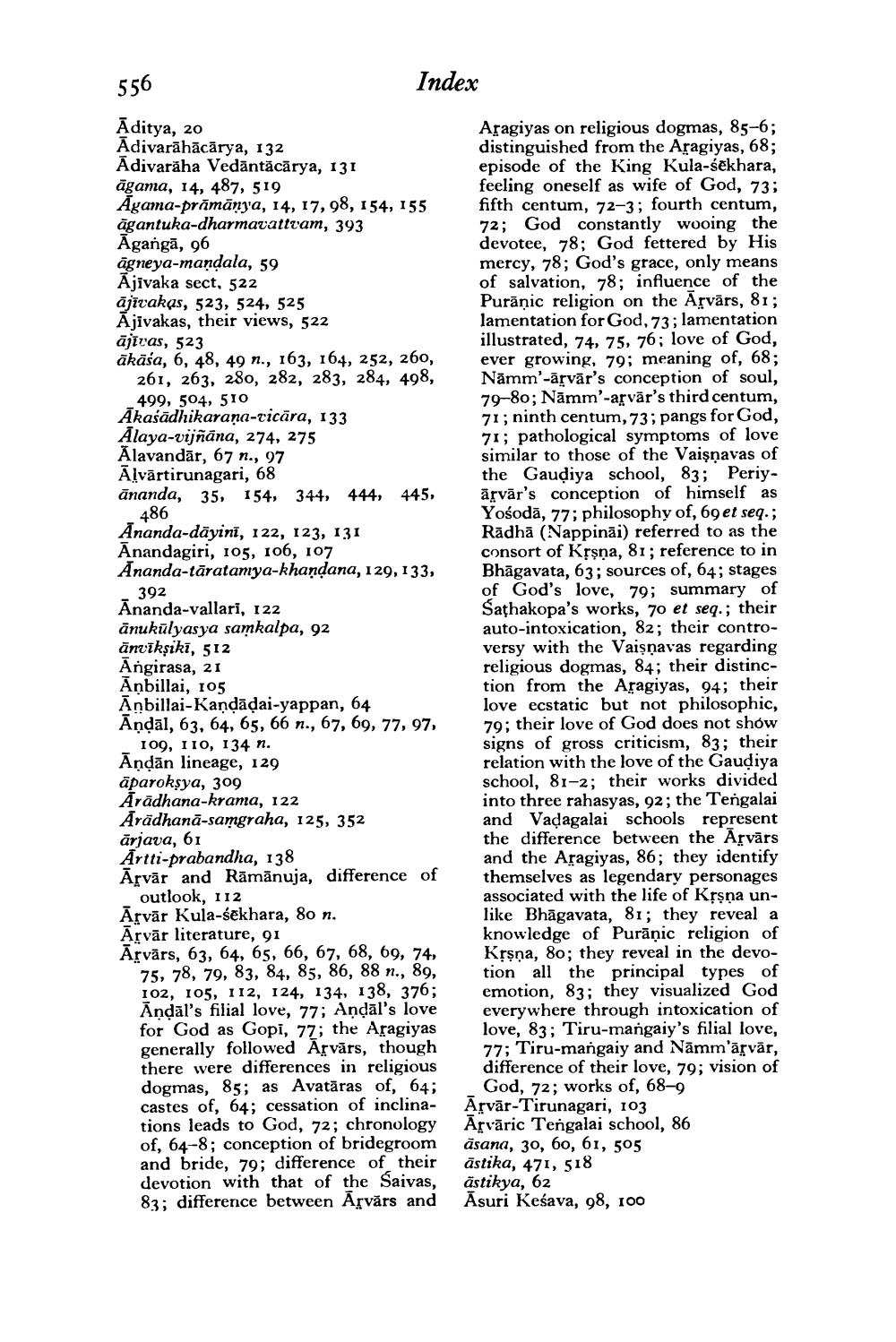________________
556
Aditya, 20
Adivarāhācārya, 132 Adivaräha Vedāntācārya, 131 agama, 14, 487, 519 Agama-pramanya, 14, 17, 98, 154, 155 agantuka-dharmavattvam, 393 Āgangā, 96 agneya-maṇḍala, 59 Ajivaka sect, 522 ajivakas, 523, 524, 525 Ajivakas, their views, 522
ājīvas, 523
ākāśa, 6, 48, 49 n., 163, 164, 252, 260, 261, 263, 280, 282, 283, 284, 498, 499, 504, 510
Akasadhikarana-vicāra, 133
Alaya-vijñāna, 274, 275 Älavandar, 67 n., 97 Alvartirunagari, 68
Index
ānanda, 35, 154, 344, 444, 445, 486
Ananda-dayini, 122, 123, 131 Anandagiri, 105, 106, 107 Ananda-taratamya-khaṇḍana, 129, 133,
392
Ananda-vallari, 122
ānukulyasya samkalpa, 92
ānvīkṣiki, 512 Angirasa, 21
Anbillai, 105
Anbillai-Kandaḍai-yappan, 64
Aṇḍāl, 63, 64, 65, 66 n., 67, 69, 77, 97, 109, 110, 134 n. Andan lineage, 129
aparokṣya, 309 Aradhana-krama, 122 Aradhana-samgraha, 125, 352 ārjava, 61
Artti-prabandha, 138 Arvär and Rāmānuja, difference of outlook, 112
Arvar Kula-sekhara, 80 n.
Arvär literature, 91
Ārvārs, 63, 64, 65, 66, 67, 68, 69, 74, 75, 78, 79, 83, 84, 85, 86, 88 n., 89, 102, 105, 112, 124, 134, 138, 376; Andal's filial love, 77; Andal's love for God as Gopi, 77; the Aragiyas generally followed Arvars, though there were differences in religious dogmas, 85; as Avatāras of, 64; castes of, 64; cessation of inclinations leads to God, 72; chronology of, 64-8; conception of bridegroom and bride, 79; difference of their devotion with that of the Saivas, 83; difference between Arvärs and
Aragiyas on religious dogmas, 85-6; distinguished from the Aragiyas, 68; episode of the King Kula-sekhara, feeling oneself as wife of God, 73; fifth centum, 72-3; fourth centum, 72; God constantly wooing the devotee, 78; God fettered by His mercy, 78; God's grace, only means of salvation, 78; influence of the Puranic religion on the Arvärs, 81; lamentation for God, 73; lamentation illustrated, 74, 75, 76; love of God, ever growing, 79; meaning of, 68; Namm'-ārvār's conception of soul, 79-80; Nämm'-arvär's third centum, 71; ninth centum, 73; pangs for God, 71; pathological symptoms of love similar to those of the Vaisnavas of the Gaudiya school, 83; Periyarvar's conception of himself as Yośoda, 77; philosophy of, 69 et seq.; Rādhā (Nappinãi) referred to as the consort of Kṛṣṇa, 81; reference to in Bhāgavata, 63; sources of, 64; stages of God's love, 79; summary of Sathakopa's works, 70 et seq.; their auto-intoxication, 82; their controversy with the Vaisnavas regarding religious dogmas, 84; their distinction from the Aragiyas, 94; their love ecstatic but not philosophic, 79; their love of God does not show signs of gross criticism, 83; their relation with the love of the Gaudiya school, 81-2; their works divided into three rahasyas, 92; the Tengalai and Vaḍagalai schools represent the difference between the Arvārs and the Aragiyas, 86; they identify themselves as legendary personages associated with the life of Kṛṣṇa unlike Bhāgavata, 81; they reveal a knowledge of Puranic religion of Kṛṣṇa, 80; they reveal in the devotion all the principal types of emotion, 83; they visualized God everywhere through intoxication of love, 83; Tiru-mangaiy's filial love, 77; Tiru-mangaiy and Namm'āṛvär, difference of their love, 79; vision of God, 72; works of, 68-9 Arvar-Tirunagari, 103 Arvaric Tengalai school, 86 äsana, 30, 60, 61, 505 ästika, 471, 518 ästikya, 62 Asuri Keśava, 98, 100




